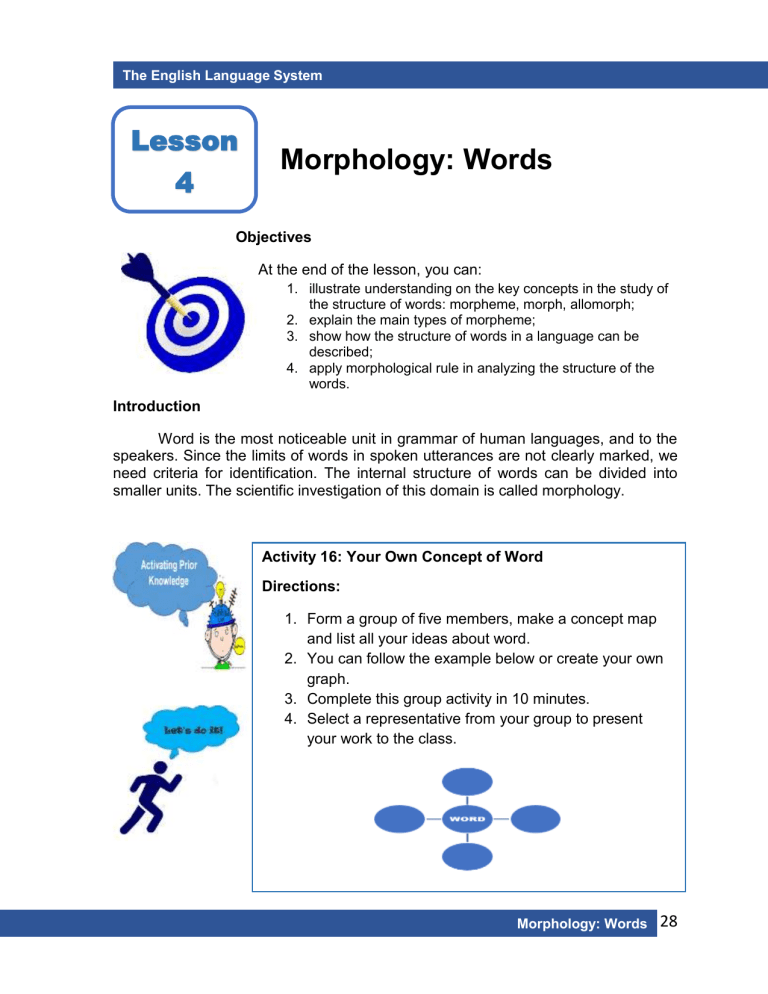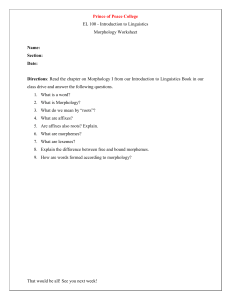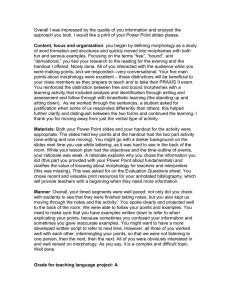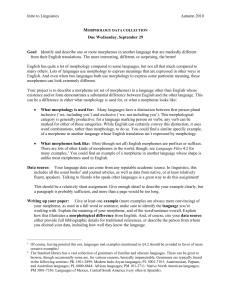
The English Language System Lesson 4 Morphology: Words Objectives At the end of the lesson, you can: 1. illustrate understanding on the key concepts in the study of the structure of words: morpheme, morph, allomorph; 2. explain the main types of morpheme; 3. show how the structure of words in a language can be described; 4. apply morphological rule in analyzing the structure of the words. Introduction Word is the most noticeable unit in grammar of human languages, and to the speakers. Since the limits of words in spoken utterances are not clearly marked, we need criteria for identification. The internal structure of words can be divided into smaller units. The scientific investigation of this domain is called morphology. Activity 16: Your Own Concept of Word Directions: 1. Form a group of five members, make a concept map and list all your ideas about word. 2. You can follow the example below or create your own graph. 3. Complete this group activity in 10 minutes. 4. Select a representative from your group to present your work to the class. Morphology: Words 28 The English Language System Morphology Morphology is a system of categories and rules involved in word formation and interpretation. There are two basic goals in studying morphology: to isolate the component parts of words; and to determine the rules by which words are formed Morphemes, allomorphs and morphs Although a morpheme is an abstract unit of meaning, a morph is a formal unit with a physical shape. A morpheme is the description of what a morph is or does to a word. Morphs are the actual forms used to realize morphemes. Example: mats [mat + (-s)] ashes [ash + (-es)] On the other hand, allomorphs are any of the different forms of a morpheme. Example: Past Tense: rolled [-d], walked [-t], gifted [-ed] o Morpheme: [-d] o Allomorphs: /-d/ /-t/ /-ed/ Plural Formation: flasks [-s], wars [-z], glasses [-ez] o Morpheme: [-s] o Allomorphs: /-s/ /-z/ /-ez/ Activity 17: Writing Morphemic Rules Directions: 1. You will do this activity individually. 2. Write your answer on the space provided. 3. Here are the tasks you will be doing: a. Determine the allomorphs of this prefix. b. Write a morphemic rule, specifying the underlying form, allomorphs, and conditioning environments. c. State the meaning of the morpheme, if possible. 4. Complete the tasks in 15 minutes. Morphology: Words 29 Form a group with five members. Using a graph (venn diagram, table, concept map, etc.), illustrate your own understanding on the key concepts of morphology (morpheme, The English Language System collect correct connect commute combat compute compare cohabit coalesce collate commend contend consent condemn collide corrode confess cohere coexist coincide Samples taken from Brinton, L. J., & Brinton, D. (2010). The linguistic structure of modern English. John Benjamins Publishing. Retrieved from https://benjamins.com/sites/z.156/exercise/c4q5 Morphology: Words 30 The English Language System Activity 18: A Brief History of Plural Word…s Directions: 1. We will be watching a video about the story behind the plural morpheme…s from https://www.youtube.com/watch?v=_gwJHuEa9 Jc&t=4s 2. Share your insights and realizations about it in three (3) paragraphs with no more than five (5) sentences each. 3. Write your answer on the space provided. 4. Complete this activity within 10 minutes. Morphology: Words 31 The English Language System Morphology: Words 32 The English Language System Activity 19: Types of Morpheme Directions: 1. Find two companions, get ideas from the figures above, and explain the main types of morpheme. 2. Write your answer on the space provided. 3. Select a representative from your group to present your work. 4. Finish this activity in five (5) minutes. Morphology: Words 33 The English Language System Activity 20: Directions: 1. With your companions and complete the chart about the major differences between derivational and inflectional morphology. 2. Write your answer on the chart provided. 3. Select a representative from your group to present your work. 4. Finish this activity in five (5) minutes. Derivational Inflectional position addable on to? changes stem? productive? meaning? Morphology: Words 34 The English Language System Morphological Description Word Free/ Bound Open/ Closed engage -ment -s Free Bound Bound Open discharge -d Bound Free Bound Open Inflectional/ Derivational Root/Affix (prefix/suffix) engagements Derivational Inflectional Root Suffix Suffix discharged Derivational Inflectional Prefix Root Suffix The table above shows how to describe morphemes. Activity 21: Morphological Description Directions: A. On the space provided below, identify and describe the following morphemes based on how the sample morphemes on the table above were identified and described. B. DIY (Do it yourself) C. You have 10 minutes to complete this task. Word Free/ Bound Open/ Inflectional/ Root/Affix (prefix/suffix) Closed Derivational 1. Unexpectedly 2. Rearrangements 3. Insufficiencies Morphology: Words 35 The English Language System The Hierarchical Structure of Words Affixes cannot be not attached to the root simultaneously. Morphemes in words have a strict and systematic linear order. Within words, morphemes are also organized in highly patterned ways. To provide a more complete representation of the structure of a word, we need to consider the following: The fact that every simple word contains one root. The derivational affixes in the word contain meanings. The fact that each lexical item represents a part of speech. To visualize the hierarchical structure of words we can use trees, just as we can with sentences and grammar. Morphology: Words 36 The English Language System Activity 22: The Hierarchical Structure of Words Directions: A. On the sheet provided below, illustrate the hierarchy of the affixes attached to the root words. a. Misconceptions b. Underestimated c. Rearrangements B. Do it individually. C. You have 10 minutes to complete this task. Morphology: Words 37 The English Language System References Text books: Brinton, L. J. (2000). The structure of modern English: A linguistic introduction (Vol. 1). John Benjamins Publishing. Carstairs-McCarthy, A. (2017). Introduction to English Morphology: Words and their Structure. Edinburgh University Press. Haspelmath, M., & Sims, A. (2013). Understanding morphology. Routledge. Lieber, R. (2015). Introducing morphology. Cambridge University Press. Morphology: Words 38 The English Language System McGregor, W. B. (2009). Linguistics: an introduction. Continuum International Publishing Group. Online Sources: Brinton, L. J., & Brinton, D. (2010). The linguistic structure of modern English. John Benjamins Publishing. Retrieved from https://benjamins.com/sites/z.156/exercise/c4q5 McWorther, J. (2013, July 22). A brief history of the plural…s [TED-Ed]. Retrieved from https://www.youtube.com/watch?v=_gwJHuEa9Jc&t=4s Morphology: Words 39






